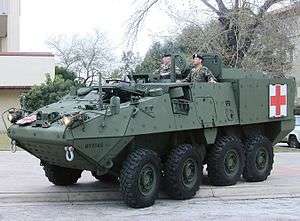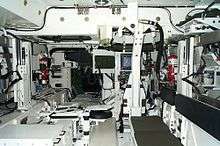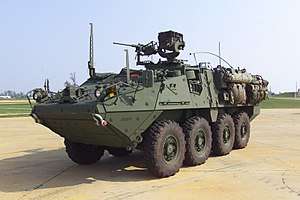M1133 Medical Evacuation Vehicle
The Medical Evacuation Vehicle (MEV) are assigned from the Battalion Aid Station for Battalion-sized units, and dedicated to each of the company-sized elements of the unit and provide treatment for serious injury and advanced trauma cases.
| M1133 Medical Evacuation Vehicle | |
|---|---|
 Stryker MEV [1] | |
| Specifications | |
| Mass | ICV: 16.47 t (18.12 sh tn) |
| Length | 6.95 m (22.92 ft) |
| Width | 2.72 m (8.97 ft) |
| Height | 2.64 m (8.72 ft) |
| Crew | 3 |
| Passengers | up to 6 patients |
| Armor | 14.5 mm[1] |
Main armament | None |
| Engine | diesel 260 kW (350 hp) |
| Power/weight | ICV: 15.8 kW/t (19.3 hp/sh tn) |
| Suspension | 8×8 wheeled |
Operational range | 500 km (300 mi) |
| Maximum speed | 100 km/h (62 mph) |
General
Integrated medical evacuation support in the SBCT (Stryker Brigade Combat Team), as an integrated part of the internetted combat forward formation, helps the organic medic who accompanies the infantry soldier during dismounted operations. The Medical Evacuation Vehicle and its crew can move forward, covered by integrated overwatching fires which provide protection for the patient and medical team.
This capability keeps the other platforms of the formation free to sustain the integrated support of the assault. The evacuation will include emergency care en route enhanced by the medic and by a protected environment with adequate lighting and accessible medical equipment.
Operational capability
The Medical Evacuation Vehicle is the primary ambulance platform in units equipped with the Stryker family of vehicles. It is based on the infantry carrier variant. The commonality of the platforms reduces the maintenance footprint and variety of logistics support.

The Medical Evacuation Vehicle has an accessible attendant’s seat that allows the attendant to monitor patients.
The ambulance is marked with Geneva Convention insignia that can be removed or masked without altering the camouflage pattern. It has a hydraulically operated rear ramp. This reduces risk of exposure to hostile activity or inclement weather.
Sources
This article incorporates work from https://web.archive.org/web/20080516205926/http://www.sbct.army.mil/product_mev.html, which is in the public domain as it is a work of the United States Military.
References
- "Army Fact File - Stryker". Archived from the original on 2006-07-27. Retrieved 2006-07-31.
| Wikimedia Commons has media related to M1133 Medical Evacuation Vehicle. |
